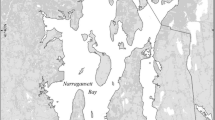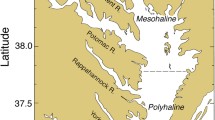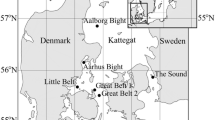Abstract
Freshwater inputs often play a more direct role in estuarine phytoplankton biomass (chlorophyll a) accumulation than nitrogen (N) inputs, since discharge simultaneously controls both phytoplankton residence time and N loading. Understanding this link is critical, given potential changes in climate and human activities that may affect discharge and watershed N supply. Chlorophyll a (chla) relationships with hydrologic variability were examined in 3-year time series from two neighboring, shallow (<5 m), microtidal estuaries (New and Neuse River estuaries, NC, USA) influenced by the same climatic conditions and events. Under conditions ranging from drought to floods, N concentration and salinity showed direct positive and negative responses, respectively, to discharge for both estuaries. The response of chla to discharge was more complex, but was elucidated through conversion of discharge to freshwater flushing time, an estimate of transport time scale. Non-linear fits of chla to flushing time revealed non-monotonic, unimodal relationships that reflected the changing balance between intrinsic growth and losses through time and along the axis of each estuary. Maximum biomass occurred at approximately 10-day flushing times for both systems. Residual analysis of the fitted data revealed positive relationships between chla and temperature, suggesting enhanced growth rates at higher temperatures. N loading and system-wide, volume-weighted chla were positively correlated, and biomass yields per N load were greater than other marine systems. When combined with information on loss processes, these results on the hydrologic control of phytoplankton biomass will help formulate mechanistic models necessary to predict ecosystem responses to future climate and anthropogenic changes.









Similar content being viewed by others
References
Alber, M., and J.E. Sheldon. 1999. Use of a date-specific method to examine variability in the flushing times of Georgia estuaries. Estuarine, Coastal and Shelf Science 49: 469–482.
Anderson, D.M., and K.D. Stolzenbach. 1985. Selective retention of two dinoflagellates in a well-mixed estuarine embayment: The importance of diel vertical migration and surface avoidance. Marine Ecology Progress Series 25: 39–50.
Arar, E.J., W.L. Budde, and T.D. Behymer. 1997. Methods for the determination of chemical substances in marine and environmental matrices. EPA/600/R-97/072. Cincinnati: National Exposure Research Laboratory, US Environmental Protection Agency.
Borsuk, M.E., C.A. Stow, and K.H. Reckhow. 2004. Confounding effect of flow on estuarine response to nitrogen loading. Journal of Environmental Engineering 130: 605–614.
Boyer, J.N., R.R. Christian, and D.W. Stanley. 1993. Patterns of phytoplankton primary productivity in the Neuse River estuary, North Carolina, USA. Marine Ecology Progress Series 97: 287–297.
Bricker, S.B., C.G. Clement, D.E. Pirhalla, S.P. Orlando, and D.R.G. Farrow. 1999. National Estuarine Eutrophication Assessment: Effects of nutrient enrichment in the Nation’s estuaries. Silver Spring: NOAA, National Ocean Service, Special Projects Office and the National Centers for Coastal Ocean Science.
Brussaard, C.P.D. 2004. Viral control of phytoplankton populations—A review. The Journal of Eukaryotic Microbiology 51: 125–138.
Christian, R.R., J.N. Boyer, and D.W. Stanley. 1991. Multi-year distribution patterns of nutrients within the Neuse River Estuary, North Carolina. Marine Ecology Progress Series 71: 259–274.
Cloern, J.E. 2001. Our evolving conceptual model of the coastal eutrophication problem. Marine Ecology Progress Series 210: 223–253.
Ensign, S.H., J.N. Halls, and M.A. Mallin. 2004. Application of digital bathymetry data in an analysis of flushing times of two large estuaries. Computers & Geosciences 30: 501–511.
Fisher, T.R., P.R. Carlson, and R.T. Barber. 1982. Sediment nutrient regeneration in three North Carolina estuaries. Estuarine, Coastal and Shelf Science 14: 101–116.
Hall, M.J., H.F.P. Van Den Boogaard, R.C. Fernando, and A.E. Mynett. 2004. The construction of confidence intervals for frequency analysis using resampling techniques. Hydrology and Earth System Sciences 8: 235–246.
Hall, N.S., and H.W. Paerl. 2011. Vertical migration patterns of phytoflagellates in relation to light and nutrient availability in a shallow, microtidal estuary. Marine Ecology Progress Series 425: 1–19.
Hall, N.S., H.W. Paerl, K.L. Rossignol, and B.L. Peierls. 2012. Effects of climatic variability on phytoplankton biomass and community structure in the eutrophic, microtidal, New River Estuary, North Carolina, USA. Estuarine, Coastal and Shelf Science (in revision).
Hein, T., C. Baranyi, G.J. Herndl, W. Wanek, and F. Schiemer. 2003. Allochthonous and autochthonous particulate organic matter in floodplains of the River Danube: The importance of hydrological connectivity. Freshwater Biology 48: 220–232.
Keller, A.A., C.A. Oviatt, H.A. Walker, and J.D. Hawk. 1999. Predicted impacts of elevated temperature on the magnitude of the winter-spring phytoplankton bloom in temperate coastal waters: A mescosm study. Limnology and Oceanography 44: 344–356.
Ketchum, B.H. 1954. Relation between circulation and planktonic populations in estuaries. Ecology 35: 191–200.
Litaker, R.W., P.A. Tester, C.S. Duke, B.E. Kenney, J.L. Pinckney, and J. Ramus. 2002. Seasonal niche strategy of the bloom-forming dinoflagellate Heterocapsa triquetra. Marine Ecology Progress Series 232: 45–62.
Lucas, L.V., J.K. Thompson, and L.R. Brown. 2009. Why are diverse relationships observed between phytoplankton biomass and transport time? Limnology and Oceanography 54: 381–390.
Luettich, R.A., Jr., J.E. McNinch, H.W. Paerl, C.H. Peterson, J.T. Wells, M. Alperin, C.S. Martens, and J.L. Pinckney. 2000. Neuse River Estuary modeling and monitoring project stage 1: Hydrography and circulation, water column nutrients and productivity, sedimentary processes and benthic-pelagic coupling, and benthic ecology. Water Resources Research Institute Report No. 325-B. Raleigh: Water Resources Research Institute of the University of North Carolina.
Luettich Jr., R.A., S.D. Carr, J.V. Reynolds-Fleming, C.W. Fulcher, and J.E. Mcninch. 2002. Semi-diurnal seiching in a shallow, micro-tidal lagoonal estuary. Continental Shelf Research 22: 1669–1681.
Mallin, M.A., M.R. Mciver, H.A. Wells, D.C. Parsons, and V.L. Johnson. 2005. Reversal of eutrophication following sewage treatment upgrades in the New River Estuary, North Carolina. Estuaries 28: 750–760.
Monsen, N.E., J.E. Cloern, L.V. Lucas, and S.G. Monismith. 2002. A comment on the use of flushing time, residence time, and age as transport time scales. Limnology and Oceanography 47: 1545–1553.
National Climatic Data Center. 2010. State of the Climate National Overview, September 2010. www.ncdc.noaa.gov/sotc/national/2010/9#SERCC. Accessed 20 October 2011.
Nixon, S.W. 1992. Quantifying the relationship between nitrogen input and the productivity of marine ecosystems. In Proceedings of advanced marine technology conference, Vol. 5, eds. M. Takahashi, K. Nakata, and T.R. Parsons, 57–83. Tokyo.
Nixon, S.W. 2009. Eutrophication and the macroscope. Hydrobiologia 629: 5–19.
Paerl, H.W., J.L. Pinckney, J.M. Fear, and B.L. Peierls. 1998. Ecosystem responses to internal and watershed organic matter loading: Consequences for hypoxia in the eutrophying Neuse River Estuary, North Carolina, USA. Marine Ecology Progress Series 166: 17–25.
Paerl, H.W., L.M. Valdes, A.R. Joyner, M.F. Piehler, and M.E. Lebo. 2004. Solving problems resulting from solutions: Evolution of a dual nutrient management strategy for the eutrophying Neuse River Estuary, North Carolina. Environmental Science & Technology 38: 3068–3073.
Paerl, H.W., L.M. Valdes-Weaver, A.R. Joyner, and V. Winkelmann. 2007. Phytoplankton indicators of ecological change in the eutrophying Pamlico Sound system, North Carolina. Ecological Applications 17: S88–S101.
Paerl, H.W., R.R. Christian, J.D. Bales, B.L. Peierls, N.S. Hall, A.R. Joyner, and S.R. Riggs. 2010. Assessing the response of the Pamlico Sound, North Carolina, USA to human and climatic disturbances: Management implications. In Coastal lagoons: Critical habitats of environmental change, ed. M. Kennish and H. Paerl, 17–42. Boca Raton: CRC.
Peierls, B.L., R.R. Christian, and H.W. Paerl. 2003. Water quality and phytoplankton as indicators of hurricane impacts on a large estuarine ecosystem. Estuaries 26: 1329–1343.
Pinckney, J.L., D.F. Millie, B.T. Vinyard, and H.W. Paerl. 1997. Environmental controls of phytoplankton bloom dynamics in the Neuse River Estuary, North Carolina, U.S.A. Canadian Journal of Fisheries and Aquatic Sciences 54: 2491–2501.
R Development Core Team. 2011. R: A language and environment for statistical computing. Vienna: R Foundation for Statistical Computing.
Raven, J.A., and R.J. Geider. 1988. Temperature and algal growth. The New Phytologist 110: 441–461.
Reynolds-Fleming, J.V., and R.A. Luettich Jr. 2004. Wind-driven lateral variability in a partially mixed estuary. Estuarine, Coastal and Shelf Science 60: 395–407.
Rudek, J., H.W. Paerl, M.A. Mallin, and P.W. Bates. 1991. Seasonal and hydrological control of phytoplankton nutrient limitation in the lower Neuse River Estuary, North Carolina. Marine Ecology Progress Series 75: 133–142.
Ryther, J.H., and W.M. Dunstan. 1971. Nitrogen, phosphorus, and eutrophication in the coastal marine environment. Science 171: 1008–1013.
Singh, V.P. 1997. Effect of spatial and temporal variability in rainfall and watershed characteristics on stream flow hydrograph. Hydrological Processes 11: 1649–1669.
Swaney, D.P., D. Scavia, R.W. Howarth, and R.M. Marino. 2008. Estuarine classification and response to nitrogen loading: Insights from simple ecological models. Estuarine, Coastal and Shelf Science 77: 253–263.
Tomas, C.R., J. Peterson, and A.O. Tatters. 2007. Harmful algal species from Wilson Bay, New River, North Carolina: Composition, nutrient bioassay and HPLC pigment analysis. UNC-WRRI-369. , Raleigh: Water Resources Research Institute of the University of North Carolina.
Tyler, M.A., and H.H. Seliger. 1978. Annual subsurface transport of a red tide dinoflagellate to its bloom area: Water circulation patterns and organism distributions in the Chesapeake Bay. Limnology and Oceanography 23: 227–246.
Walz, N., and M. Welker. 1998. Plankton development in a rapidly flushed lake in the River Spree system (Neuendorfer See, Northeast Germany). Journal of Plankton Research 20: 2071–2087.
Welschmeyer, N.A. 1994. Fluorometric analysis of chlorophyll a in the presence of chlorophyll b and pheopigments. Limnology and Oceanography 39: 1985–1992.
Woodruff, D.L., R.P. Stumpf, J.A. Scope, and H.W. Paerl. 1999. Remote estimation of water clarity in optically complex estuarine waters. Remote Sensing of Environment 68: 41–52.
Acknowledgements
We are grateful to the many students and technicians who have helped with field sampling and laboratory analyses, especially B. Abare, J. Braddy, M. Hoffman, A. Joyner, L. Kelly, K. Rossignol, and R. Sloup. R. Guajardo provided invaluable assistance with volume calculations using GIS. We appreciate the critical and constructive comments from two anonymous reviewers. Funding for this project was provided by Strategic Environmental Research and Developmental Program (SERDP)-Defense Coastal/Estuarine Research Program Project SI-1413, the Lower Neuse Basin Association, the Neuse River Compliance Association, and National Science Foundation Projects OCE 0825466, OCE 0812913, and CBET 0932632. The views expressed are those of the authors and do not represent the policies or opinions of the US Department of Defense or associated military services.
Author information
Authors and Affiliations
Corresponding author
Rights and permissions
About this article
Cite this article
Peierls, B.L., Hall, N.S. & Paerl, H.W. Non-monotonic Responses of Phytoplankton Biomass Accumulation to Hydrologic Variability: A Comparison of Two Coastal Plain North Carolina Estuaries. Estuaries and Coasts 35, 1376–1392 (2012). https://doi.org/10.1007/s12237-012-9547-2
Received:
Revised:
Accepted:
Published:
Issue Date:
DOI: https://doi.org/10.1007/s12237-012-9547-2




